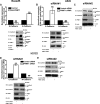PRMT1 Is a Novel Regulator of Epithelial-Mesenchymal-Transition in Non-small Cell Lung Cancer
- PMID: 25847239
- PMCID: PMC4505594
- DOI: 10.1074/jbc.M114.636050
PRMT1 Is a Novel Regulator of Epithelial-Mesenchymal-Transition in Non-small Cell Lung Cancer
Abstract
Protein arginine methyl transferase 1 (PRMT1) was shown to be up-regulated in cancers and important for cancer cell proliferation. However, the role of PRMT1 in lung cancer progression and metastasis remains incompletely understood. In the present study, we show that PRMT1 is an important regulator of epithelial-mesenchymal transition (EMT), cancer cell migration, and invasion, which are essential processes during cancer progression, and metastasis. Additionally, we have identified Twist1, a basic helix-loop-helix transcription factor and a well-known E-cadherin repressor, as a novel PRMT1 substrate. Taken together, we show that PRMT1 is a novel regulator of EMT and arginine 34 (Arg-34) methylation of Twist1 as a unique "methyl arginine mark" for active E-cadherin repression. Therefore, targeting PRMT1-mediated Twist1 methylation might represent a novel strategy for developing new anti-invasive/anti-metastatic drugs. Moreover, methylated Twist1 (Arg-34), as such, could also emerge as a potential important biomarker for lung cancer.
Keywords: N-cadherin; Prmt1; Twist1; cadherin-1 (CDH1) (epithelial cadherin) (E-cadherin); epithelial-mesenchymal transition (EMT); metastasis; protein methylation.
© 2015 by The American Society for Biochemistry and Molecular Biology, Inc.
Figures






Similar articles
-
Twist may be associated with invasion and metastasis of hypoxic NSCLC cells.Tumour Biol. 2016 Jul;37(7):9979-87. doi: 10.1007/s13277-016-4896-2. Epub 2016 Jan 27. Tumour Biol. 2016. PMID: 26819207
-
MicroRNA-106b modulates epithelial-mesenchymal transition by targeting TWIST1 in invasive endometrial cancer cell lines.Mol Carcinog. 2014 May;53(5):349-59. doi: 10.1002/mc.21983. Epub 2013 Sep 3. Mol Carcinog. 2014. PMID: 24002805
-
Promotion of hepatocellular carcinoma metastasis through matrix metalloproteinase activation by epithelial-mesenchymal transition regulator Twist1.J Cell Mol Med. 2011 Mar;15(3):691-700. doi: 10.1111/j.1582-4934.2010.01052.x. J Cell Mol Med. 2011. PMID: 20219012 Free PMC article.
-
Normal and disease-related biological functions of Twist1 and underlying molecular mechanisms.Cell Res. 2012 Jan;22(1):90-106. doi: 10.1038/cr.2011.144. Epub 2011 Aug 30. Cell Res. 2012. PMID: 21876555 Free PMC article. Review.
-
The roles of HLH transcription factors in epithelial mesenchymal transition and multiple molecular mechanisms.Clin Exp Metastasis. 2014 Mar;31(3):367-77. doi: 10.1007/s10585-013-9621-6. Epub 2013 Oct 26. Clin Exp Metastasis. 2014. PMID: 24158354 Review.
Cited by
-
How Protein Methylation Regulates Steroid Receptor Function.Endocr Rev. 2022 Jan 12;43(1):160-197. doi: 10.1210/endrev/bnab014. Endocr Rev. 2022. PMID: 33955470 Free PMC article. Review.
-
Histone methyltransferase and drug resistance in cancers.J Exp Clin Cancer Res. 2020 Aug 28;39(1):173. doi: 10.1186/s13046-020-01682-z. J Exp Clin Cancer Res. 2020. PMID: 32859239 Free PMC article. Review.
-
The Post-Translational Regulation of Epithelial-Mesenchymal Transition-Inducing Transcription Factors in Cancer Metastasis.Int J Mol Sci. 2021 Mar 30;22(7):3591. doi: 10.3390/ijms22073591. Int J Mol Sci. 2021. PMID: 33808323 Free PMC article. Review.
-
PRMT1-Dependent Macrophage IL-6 Production Is Required for Alcohol-Induced HCC Progression.Gene Expr. 2019 Apr 18;19(2):137-150. doi: 10.3727/105221618X15372014086197. Epub 2018 Sep 18. Gene Expr. 2019. PMID: 30236171 Free PMC article.
-
Protein arginine methyltransferase 1 promoted the growth and migration of cancer cells in esophageal squamous cell carcinoma.Tumour Biol. 2016 Feb;37(2):2613-9. doi: 10.1007/s13277-015-4098-3. Epub 2015 Sep 22. Tumour Biol. 2016. PMID: 26392112
References
-
- Yang Y., Bedford M. T. (2013) Protein arginine methyltransferases and cancer. Nature Reviews. Cancer 13, 37–50 - PubMed
-
- Cha B., Jho E. H. (2012) Protein arginine methyltransferases (PRMTs) as therapeutic targets. Exp. Opin. Therap. Targets 16, 651–664 - PubMed
-
- Paik W. K., Kim S. (1968) Protein methylase I. Purification and properties of the enzyme. J. Biol. Chem. 243, 2108–2114 - PubMed
-
- Lin W. J., Gary J. D., Yang M. C., Clarke S., Herschman H. R. (1996) The mammalian immediate-early TIS21 protein and the leukemia-associated BTG1 protein interact with a protein-arginine N-methyltransferase. J. Biol. Chem. 271, 15034–15044 - PubMed
-
- Boffa L. C., Karn J., Vidali G., Allfrey V. G. (1977) Distribution of NG, NG,-dimethylarginine in nuclear protein fractions. Biochem. Biophys. Res. Commun. 74, 969–976 - PubMed
Publication types
MeSH terms
Substances
Grants and funding
LinkOut - more resources
Full Text Sources
Other Literature Sources
Medical
Molecular Biology Databases
Research Materials
Miscellaneous

